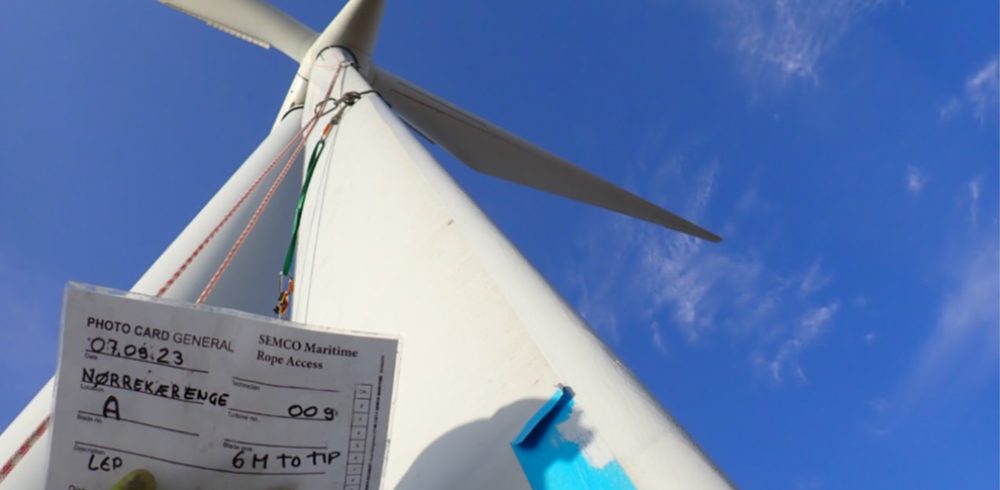In order to achieve net-zero by 2050, according to a 2023 Report from the world-leading authority on climate science, Climate Action Tracker: ‘wind and solar sources in electricity generation will need to reach 57 – 78 percent by 2030, and 79 – 96 percent by 2050.’ In 2022, this figure sat at 12 percent. Needless to say, a colossal scale-up of these industries is anticipated over the upcoming decades.
Polymeric Technology Supports Transition to 79 – 96% Renewable Energy by 2050
Given the important role wind power plays in the transition to net zero, it is absolutely critical that windfarms are maintained to an excellent standard. Otherwise, damaged wind power assets may needlessly be decommissioned and replaced; the process of which comes with a hefty carbon footprint as well as considerable financial expenditure.
As such, asset owners are investing in a simple yet extremely beneficial (both from a cost and environmental perspective) solution to extend the lifespan of wind turbines. This solution involves the use of polymeric repair composites and high-performance protective coatings to repair and protect key assets in the wind industry. This includes: turbine blades, nacelles and generating components, turbine bases, towers, transformers, amongst other assets.
The use of this technology is based on a circular economic business model: repairing damaged assets rather than replacing them. In turn, not only does this mitigate the carbon footprint incurred during the replacement process, but it is also enables the asset owner to make significant financial savings as well.
Case Study: 42 Wind Turbine Blades Repaired and Protected
At an onshore Windfarm in Denmark, 42 wind turbine blades were exhibiting signs of severe erosion on the leading edges. Previously, the Customer had used pre-formed shells that were bonded onto the substrate to provide leading edge protection. However, this process proved to be extremely time-consuming and expensive. Therefore, the Customer was seeking an alternative solution which would be financially viable and also ensure optimal operation for many years to come.
Specification of Polymeric Leading Edge Protection System
Based on test results, the ease of application as well as the high-quality finish that can be achieved, the Customer decided to repair and protect the leading edges with a combination of Belzona 5711 and Belzona 5721.
The thixotropic paste, Belzona 5711, which is now supplied in a larger unit and more robust side-by-side cartridge, is specially designed to be applied in conjunction with the Belzona 5721 protective coating. This solvent-free LEP system is formulated for the in-situ repair and rebuilding of leading edge erosion and impact damage on wind turbine blades.
Simple Application Method
Commenting on the application process, Morten Sivertsen, General Manager at AESSEAL Danmark A/S said: “Surface preparation was carried out on each of the 42 blades, followed by the direct application of 90 kg (198.4 lbs) of Belzona 5711 from self-mixing cartridges onto the blade. The repair area was then contoured using a piece of Belzona mixing board. Once cured, a visual inspection was conducted to ensure the application’s readiness for overcoating with 144 kg (317.5 lbs) of Belzona 5721. Using a short-bristled brush, this system was then applied to the leading edge and left to cure for 30 – 60 minutes. With three rope access technicians carrying out the applications, on average, six – nine turbine blades were completed each day.”
In-Situ Repair Ensured Minimum Downtime Was Incurred
As the polymeric systems were applied in situ without the need for specialist tools or equipment, this ensured that a fast and seamless application was carried out. Thus, this enabled the Customer to make considerable financial savings as it mitigated the profit loss that can be incurred through lengthy periods of downtime.
Safeguarding Key Wind Power Assets for the Long Term
The scaling up of the wind power industry is absolutely critical in order to support the transition to renewable energy, in keeping with the net zero by 2050 pathway. By safeguarding key assets within this industry through the use of polymeric technology, asset owners can successfully bypass the environmental and financial costs associated with asset replacement. Therefore, it could be argued that polymeric technology plays an intrinsic role in supporting this energy transition.
Manufacturing & Engineering Magazine | The Home of Manufacturing Industry News















